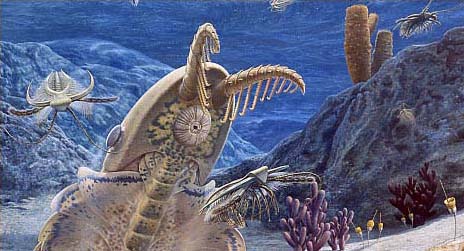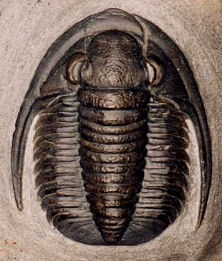 |
 |
 |
 |
 |
Produced
by the Population Genetics and Evolution class, Furman University |
||||
 |
 |
 |
 |
 |
Produced
by the Population Genetics and Evolution class, Furman University |
||||
 |
The
Cambrian: Trilobites |
 |
||
| Trilobites
are a very large and diverse group of extinct marine arthropods. They
first appeared in the fossil record during the early Cambrian, and go
extinct in the Permian at the end of the Paleozoic Era. Due to their wide
range of habitats and easily fossilized remains, the fossil record has
revealed nine orders of trilobites and somewhere between 10-15,000 species.
The large amount of diversity in trilobites is attributed to their biomineralized
exoskeletons, made of two layers of low magnesium calcite. The name trilobite
means "three-lobed", referring to the division of their bodies
into a main axial lobe with a pleural lobe on either side. The exoskeleton
is divided into three sections from front to back: a cephalon (head capsule),
thorax, and pygidium (tail), all with differing degrees of segmentation.
Although some may have been pelagic, most trilobites were benthic bottom
feeders living off of detritus. Their distinctive, large, compound eyes
gave them a view of approaching predators. Many species have long spines
to defend themselves against predators; these spines would have been particularly
effective when they rolled into a defensive ball. There is dispute over
their placement within the phylum Arthropoda. Much of this is due to the
lack of easily traceable ancestors from the Precambrian era. It’s
believed that their closest extant relatives are chelicerates like spiders,
scorpions, and horseshoe crabs (Virtual fossil Museum 2010).
Page by Megan Aprill |
 |
| Trilobite Fossil Photo credit: Gon SM. 2007. Gallery of Proetida. | |
|
Hughes, NC. 2007. The evolution of trilobite body patterning. Annu Rev Earth Pl Sc 35: 401-434. Waggoner B. 1994. Introduction to the Trilobita. University of California Museum of Paleontology (UCMP). Accessed 30 Jan, 2010. The Virtual Fossil Museum. Trilobita – Trilobites. Accessed January 30, 2010. |